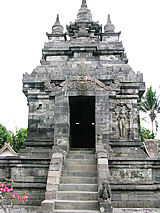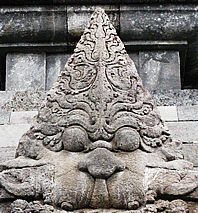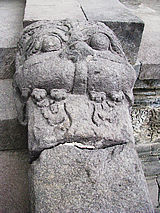Official website
of
HAN MARIE STIEKEMA
VIVA! JAVA
* Javanese mysticism
(Kebatinan) & Traditional Javanese religious tolerance: a model to the world?
*The Yogya Kraton Myth
*Taman Sari
*The Gunungan
*Tutup Ngisor
*What we can do for Java....
*Java: Land of Kala, its Candi's (Temples):
*Borobudur 1
*Borobudur 2
*Borobudur 3
*Borobudur 4
*Borobudur 5
*Borobudur 6
*Candi Mendut
*Candi Pawon
*Candi Ngawen
*Candi Sari
*Candi Kalasan
*Candi Sambisari
*Candi Prambanan
*Candi Lumbung
*Candi Bubrah
*Candi Sewu
*Candi Plaosan
*Candi Gebang
*Candi Ijo
*Candi Banyunibo
Candi Pawon
A surprise right from the
start
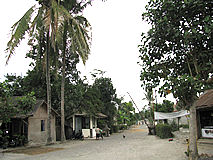 |
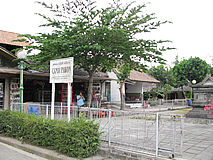 |
|
Candi Pawon |
||
 On top of the entrance a huge Kali-head |
Apart from Shivas and Buddhas.... if there is one thing that is omni-present in Javanese temples....it is Kala. The Javanese seem to be obsessed by it. The first explanation they will give to you is....that it is a guardian to the sanctuary. Well, this seems to be true. What they mostly don't realize, though, is the fact that "guardians" are the "relics" of former religions. The more powerful the original Deity, the more useful they are as protectors. Because Kala's are everywhere, one may assume that this predecessor was the Supreme Divinity. of pre-Vedic e.g. pre-Hindu pantheon. This was undoubtedly the All-Embracing Cosmic Mother. So that is what Kala originally was, later degraded to a Hindu Guardian, Demon.... If this is true, then the Javanese have always kept Her in their memories.... Mostly not aware of Her True Nature. However, the Myth of the "Queen of the South Sees" (LINK) is proof of the fact, that this connection is still alive. The unique thing about it is, that the latter corresponds with the myth of Inanna, the Goddess/Queen of Sumeria, 5000 years ago! |
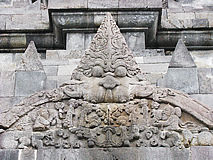 A Kala consits of a Head, two arms with on both end two dragons ("Makara's) (see photo left), leaves, trees, flowers and people making offerings (below the Head) and a Tree of Life on top... |
| The Tree of Life is symbolizing the overflowing abundance of the Cosmic Womb (Kala's Head). It is the same symbolism, that you find in the Primordial Symbol of Java and Indonesia: the Gunungan (LINK) |
Kala representing the Original Cosmic Mother, the Source of Creation and Destruction |
Scientists wonder why the Face has only a upper jaw. Well, it is symbolizing the destructive Aspect of the Cosmic Mother, Her wide-open Mouth uninterruptedly sucking in the universe. |
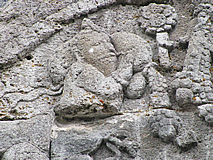 Two men bringing offerings (see also right) |
People, like everything else in the universe, are part of the Law of Creation and Destruction, something they call fate. Their existence depends on a favorable balance between the two Forces. Since archaic times it inspires them to bring offerings. |
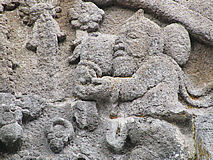 |
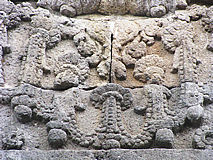 Our world of impermanence below Kala's arms |
||
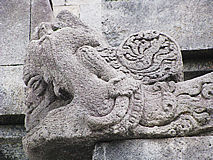 |
At both ends of Her arms are two snake/dragon-like heads, often spewing heads, babies or animals. These heads are part of the Creation aspect of the Great Mother ("Makara's). It is corresponding with the archaic notion of the Lady and Her Beasts, whereby maculinity is born out of the Eternal Feminine |
 |
At the entrance of the Temple (Womb) one often sees lion-heads with foliage or lower ranking guardians, the Beasts of the Lady. They are very similar to the Green Men as found in and on churches in Europe |
||
 ditto |
 The central chamber |
|
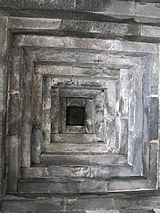 The roof, symbolizing the Cosmos as emanations from the central Womb |
||
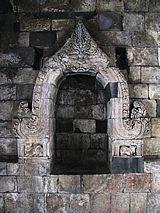 Pawon was the first temple I visited. |
One friend asked me: these your insights are unique. I have
never read anything close to it even. From where your insights come? I honestly can only
say this from insight. in the genealogy e.g. development of religions. I see an image and
without any deliberation I know the connection. Once the main traits are known, insight
into the details follow.
|
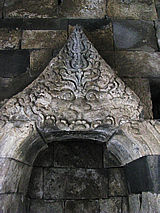 I was totally amazed, nay shocked to also find Kala's inside |
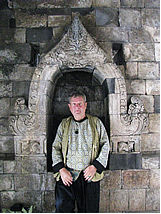 Mother and son |
||
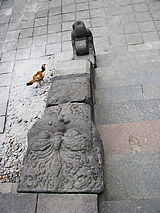 |
I looked once again to the outside of the temple. The Green Beasts/Guardians from above. | 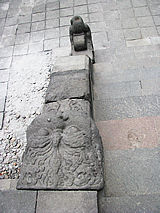 |
 |
||
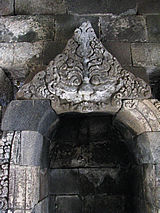 |
Isn't She utterly beautiful? Even as Demons Her Primordial Power is undeniable. It is exactly like the Green Men (LINK) of the West. They also were demonized, yet their original glance and radiation is still very much there. |  |
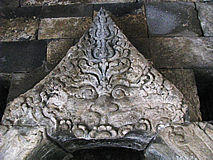 In early Hinduism Kala was called Kirtimukha |
||
 |
Pawon, like many other Candi's were dedicated to the Cosmic Womb, manifesting Herself as various Goddesses... | 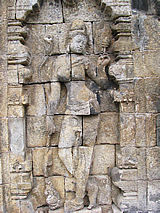 |
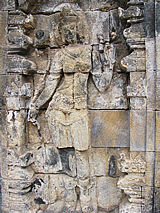 |
||
 And....as Cauldron of Abundance, in the West known as the Holy Grail. |
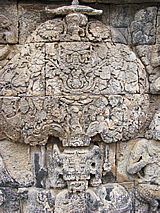 Cosmic Tree of Life, also representing abundance and fertility |
|
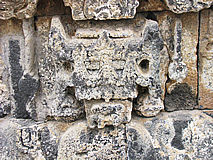 Mysterious structure under Tree of Life |
||
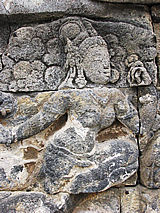 |
Two apsara-like female figurines | 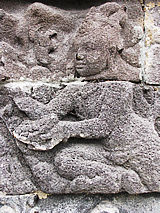 |
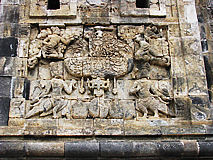 Tree of Life |
||
 Three big balls, presumably representing the Trimurti, the unity of Creation, Destruction and "Permanence" |
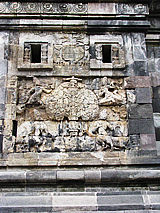 |
|
 |
||
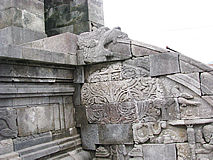 Staircase decoration |
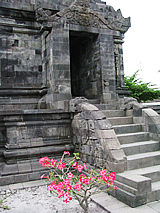 Leaving unique Pawon |
Prambanan-4
1997-2011
© Copyright Han Marie Stiekema. All rights reserved.
Everyone may use this website as a source of inspiration. However, since it
is freely given, no-one can claim, copy or derive any text, rights,
position or status from this website.
Last revising: 07/31/12
